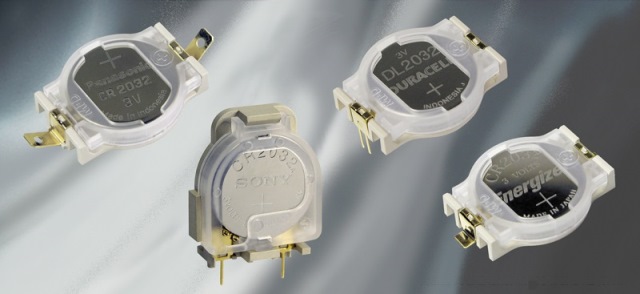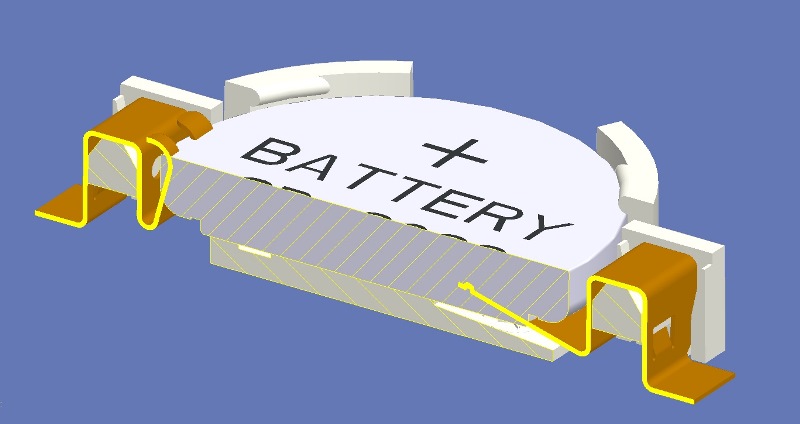The battery holder design plays a critical role in handheld medical device performance and reliability, helping minimize its size and weight to make it smaller and more streamlined
By THOMAS BLAHA
Memory Protection Devices, Inc.
www.batteryholders.com
Handheld medical devices face numerous hurdles on the way to market. First, they need to obtain FDA 510(K) pre-marketing approval for safety and effectiveness. Then, they must be manufactured to the highest quality standards using superior grade components to ensure long-term reliability and greater customer satisfaction.
All phases of product design are critical, including the selection of the battery holder. Often considered an afterthought, the battery holder plays a central role in product performance and reliability. For example, the choice of battery holder can help minimize size and weight to make the device more streamlined and miniaturized (fig.1 ). The ideal battery holder can also enhance product ruggedness to better survive normal wear-and-tear as well as the extreme abuse of being dropped and manhandled, all the while maintaining a strong electrical connection that serves as the lifeblood of the device.

Fig.1: Designers have a wide choice of coin battery holders today. Understanding those choice early helps bring a high-performance medical device to market on time.
For decades, coin cell batteries primarily sat flat on the PCB along with the other various components. However, as handheld devices have become increasingly miniaturized, a large diameter battery begins to take up a disproportionately large surface area. Radical rethinking was needed – not of how a battery should sit on a PCB, but of where a battery should sit in a PCB. As a result, vertically-oriented coin cell holders were introduced, giving product designers a choice between making the medical device wider or thicker.
To further minimize the height of vertically-oriented coin cell holders, a new option emerged, whereby a small hole was drilled in the surface of the PCB, thus allowing the battery holder to sit partially through instead of on the PCB, helping to reduce overall height. The same concept is now being applied to horizontal coin cell holders. This new style of battery holder works as both a through-hole and surface mount component, enabling it to reduce space requirements for all types of PCBs (fig.2 ).

Fig. 2: Coin-battery holders now offer a flexibility in PCB mounting to reduce space requirements for all types of board designs.
To make medical grade battery holders stronger and more resilient, it is often necessary to consider using plastic compounds other than standard polypropylene. Liquid crystal polymer (LCP) is increasingly being specified for medical grade coin cell holders, as LCP can withstand the brutal peak temperatures of 260°C that reflow ovens often operate at, and it is better able to withstand the temperature, humidity and corrosive nature of multiple autoclave and chemical sterilization cycles. Even if the contact walls are 1 mm or thinner, LCP is rigid enough to prevent weight shifting that can result in intermittent contact, plastic fractures, crushed contacts, and a host of other common problems associated with less robust plastics. Finally, LCP flows exceptionally well during the injection molding process, allowing it to meet the narrow dimensional tolerances required by medical grade handheld devices. Use of LCP can also be cost effective, since the strength of this material allows the walls to remain thin, thus keeping raw material costs relatively low (fig.3 ).

Fig. 3: Use of materials such as LCP for the housing and gold-plated bi-metallic contacts in the design of the battery holder will determine how well it will perform in service over time.
Of course, having a battery holder with a thin but strong housing means nothing if the contacts aren’t maintaining a reliable connection with the battery. Over time, battery contacts constructed out of tin-plated steel will not hold up as well as contacts constructed with gold plating over nickel over copper plating over a phosphor bronze base. The nonreactive nature of gold makes gold-plated contacts more resilient to the corrosive effects of multiple sterilization cycles. Use of gold plating also helps prevent corrosion problems associated with bi-metallic contact, as well as temperature and humidity during shipping and storage.
A broad range of standard battery-holder options are available, providing design engineers with tremendous flexibility to quickly address even the most challenging design requirements. New types of battery holders are available that offer lower profiles, smaller footprints, and greater resistance to shock, vibration, and drops. In addition, the newest generation of battery holders feature pads with anti-wicking designs that promote more consistent and stronger solder joints, as well as re-curved positive contacts that increase durability, enhance battery retention, and reduce connection failures.
These are just some of the recent innovations that are making battery holders more robust and reliable to satisfy the unique, and necessarily strict, quality requirements of medical-grade handheld devices. However, product innovation is a two-way street, requiring continual feedback from design engineers regarding the real-life issues and concerns that confront them, as astute battery holder manufacturers can address these concerns to stay ahead of the curve in innovation and enhanced user satisfaction.
In summary, the choice of battery holder requires forethought, not afterthought, as forward-looking thinking serves to avoid unacceptable compromises, expensive redesigns, tooling changes, unwarranted customization, and other obstacles that can add cost, compromise quality, and delay time-to-market.
Advertisement
Learn more about Memory Protection Devices





